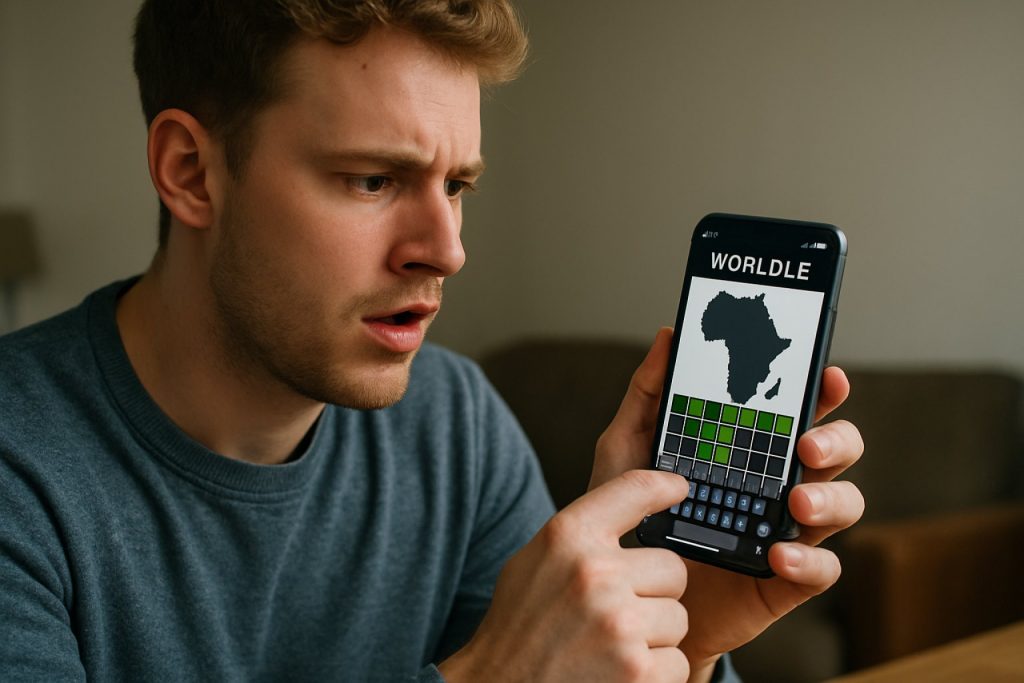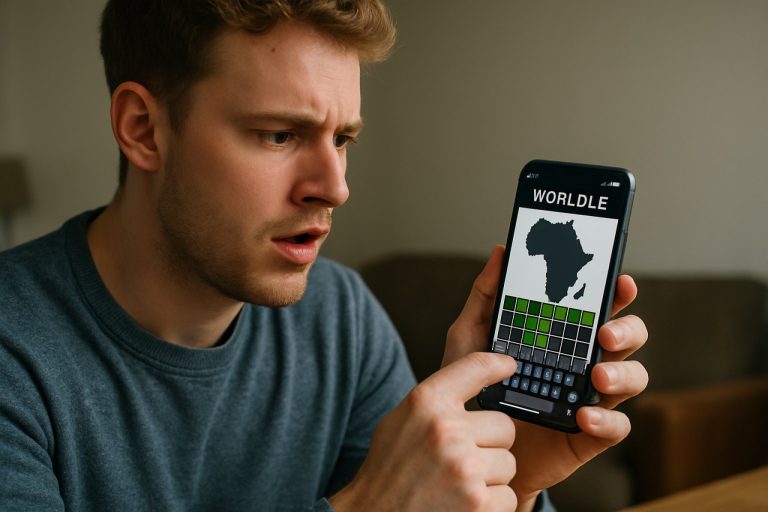
Worldle Unveiled: How a Simple Geography Guessing Game Became a Global Sensation and Transformed Online Learning. Discover the Mechanics, Impact, and Future of This Viral Phenomenon. (2025)
- Introduction: What Is Worldle and How Does It Work?
- Origins and Development: The Story Behind Worldle
- Gameplay Mechanics: Rules, Features, and User Experience
- Educational Value: Worldle’s Role in Geography Learning
- Community and Social Sharing: Building a Global Player Base
- Comparisons: Worldle vs. Other Geography and Puzzle Games
- Technology Behind Worldle: Platform, Updates, and Accessibility
- Market Growth and Public Interest: User Trends and Forecasts
- Challenges and Criticisms: Limitations and User Feedback
- Future Outlook: Innovations, Expansions, and the Next Big Steps
- Sources & References
Introduction: What Is Worldle and How Does It Work?
Worldle is an online geography guessing game that challenges players to identify countries or territories based on their silhouettes and spatial clues. Launched in early 2022 by French developer Antoine Teuf, Worldle quickly gained popularity as a daily puzzle, echoing the viral success of word-based games like Wordle. Each day, players are presented with the outline of a country or territory and have six attempts to guess its name. After each guess, Worldle provides feedback in the form of distance, direction, and proximity percentage, guiding players toward the correct answer. This interactive format not only tests geographic knowledge but also encourages learning through trial and error.
By 2025, Worldle has established itself as a staple among digital geography games, attracting millions of daily users worldwide. The game’s appeal lies in its simplicity and educational value, making it popular among students, educators, and geography enthusiasts. Worldle’s interface is accessible via web browsers and is free to play, contributing to its widespread adoption. The game’s creator, Antoine Teuf, continues to maintain and update the platform, occasionally introducing new features such as alternative map projections, regional challenges, and accessibility improvements.
Worldle’s mechanics are straightforward: after each incorrect guess, the game displays the distance in kilometers between the guessed country and the correct answer, the direction (using an arrow), and a percentage indicating how close the guess is. This feedback system encourages players to use deductive reasoning and spatial awareness, fostering a deeper understanding of world geography. The game also offers a “hard mode,” where the country’s outline is rotated, increasing the challenge for experienced players.
The educational potential of Worldle has been recognized by teachers and academic organizations, who use it as a classroom tool to engage students in geography lessons. Its success has inspired the development of similar games focusing on capitals, flags, and other geographic features. As digital learning and gamification trends continue to grow, Worldle is expected to maintain its relevance and expand its user base in the coming years. The game’s ongoing updates and community-driven features position it as a leading example of how simple, accessible digital tools can promote global awareness and geographic literacy.
Origins and Development: The Story Behind Worldle
Worldle, the geography-based guessing game, emerged in early 2022 as a creative spin on the viral word game Wordle. Developed by French web developer Antoine Teuf, Worldle challenges players to identify countries or territories based on their silhouettes, providing feedback on proximity and direction with each guess. The game’s intuitive interface and daily challenge format quickly attracted a global audience, capitalizing on the growing popularity of browser-based puzzle games and the educational potential of interactive geography.
The game’s origins are rooted in the broader trend of accessible, shareable online games that surged during the COVID-19 pandemic. Inspired by the success of Wordle, Teuf launched Worldle as a personal project, leveraging open-source map data and simple web technologies. The game’s rapid viral spread was fueled by social media sharing and word-of-mouth, with millions of daily players by mid-2022. Unlike its predecessor, Worldle emphasized visual-spatial reasoning and global knowledge, appealing to educators, students, and trivia enthusiasts alike.
Worldle’s development has been characterized by a commitment to accessibility and community engagement. Teuf has maintained the game as a free, ad-supported platform, regularly updating features based on user feedback. Notably, the game has expanded its database to include territories, islands, and regions, reflecting a more inclusive approach to global geography. The developer has also introduced multilingual support, making the game accessible to a broader international audience.
By 2025, Worldle remains independently operated, with its creator continuing to oversee updates and community interaction. The game’s enduring popularity is evident in its sustained user base and the proliferation of similar geography-themed games. Educational institutions have increasingly incorporated Worldle into classroom activities, recognizing its value in promoting geographic literacy and spatial awareness. The game’s open approach and educational focus have garnered attention from organizations such as National Geographic Society, which advocates for innovative geography education tools.
Looking ahead, Worldle’s outlook appears robust. The developer has hinted at potential collaborations with educational organizations and the integration of new gameplay modes, such as historical maps and thematic challenges. As digital learning and gamification continue to shape educational trends, Worldle is well-positioned to remain a relevant and engaging tool for geography enthusiasts and learners worldwide.
Gameplay Mechanics: Rules, Features, and User Experience
Worldle, the geography guessing game launched in early 2022, continues to captivate a global audience in 2025 with its engaging and educational gameplay mechanics. The core rules remain straightforward: each day, players are presented with the silhouette of a country, territory, or region, and must guess its name within six attempts. After each guess, the game provides feedback in the form of distance, direction, and proximity percentage, guiding users toward the correct answer. This feedback system, inspired by the mechanics of the original Wordle, encourages deductive reasoning and geographical knowledge.
Recent updates have expanded Worldle’s feature set to enhance user experience and accessibility. In 2024 and 2025, the game introduced new daily challenge modes, including “City Worldle” and “Flag Worldle,” where players identify cities from outlines or match flags to countries. These additions diversify gameplay and appeal to a broader demographic, including educators and students seeking interactive learning tools. The game’s interface remains minimalist and mobile-friendly, supporting play on both desktop and mobile browsers without requiring registration or downloads.
Worldle’s user experience is further enriched by its integration of social sharing features. Players can easily share their results on social media platforms, fostering a sense of community and friendly competition. The game’s developer, Antoine Teuf, has maintained a commitment to privacy and accessibility, ensuring that Worldle remains free to play and free from intrusive advertising, which has contributed to its sustained popularity and positive user feedback.
Looking ahead, Worldle is expected to continue evolving in response to user feedback and educational trends. Planned features for the coming years include customizable difficulty settings, expanded language support, and collaborative multiplayer modes. These enhancements aim to make the game more inclusive and adaptable for classroom use and international audiences. The game’s open approach to development and its educational value have attracted attention from geography educators and organizations promoting global literacy, positioning Worldle as a valuable tool for informal learning.
As of 2025, Worldle stands out in the digital puzzle landscape for its blend of simplicity, challenge, and educational merit. Its ongoing updates and user-centric design ensure that it remains a relevant and engaging platform for geography enthusiasts worldwide. For more information about the game and its creator, visit Worldle.
Educational Value: Worldle’s Role in Geography Learning
Worldle, the geography-based guessing game inspired by the viral success of Wordle, has continued to gain traction as an educational tool in 2025. The game challenges players to identify countries or territories based on their outlines, providing immediate feedback and additional clues such as distance and direction from the correct answer. This interactive format has proven effective in reinforcing geographic knowledge and spatial reasoning skills among users of all ages.
Recent data from educational technology forums and user communities indicate that Worldle’s daily player base remains robust, with millions of users engaging worldwide. The game’s accessibility—requiring no registration and being free to play—has contributed to its widespread adoption in both formal and informal learning environments. Teachers have increasingly integrated Worldle into classroom activities, leveraging its gamified approach to make geography lessons more engaging and memorable. Anecdotal reports from educators suggest that students demonstrate improved recall of country shapes, locations, and relative positions after regular gameplay.
In 2025, Worldle’s developers have introduced new features aimed at enhancing its educational value. These include expanded map databases, the addition of regional and thematic challenges (such as capitals, flags, and physical features), and multilingual support to cater to a global audience. Such updates align with broader trends in digital education, where interactive and adaptive learning tools are prioritized for their ability to personalize the learning experience and foster active participation.
Looking ahead, the outlook for Worldle as a geography learning resource appears positive. The game’s open-source nature has encouraged the development of spin-offs and custom versions tailored to specific curricula or age groups. Partnerships with educational organizations are under discussion, with the goal of integrating Worldle into digital classrooms and e-learning platforms. This aligns with the increasing emphasis on digital literacy and global awareness in education policy frameworks worldwide, as highlighted by organizations such as UNESCO.
- Worldle’s daily engagement numbers remain high, supporting its role as a supplementary learning tool.
- New features in 2025 focus on deeper learning, including thematic quizzes and language options.
- Educators report improved student engagement and geographic knowledge retention.
- Potential collaborations with educational bodies may further formalize Worldle’s place in curricula.
As digital games continue to shape the landscape of education, Worldle stands out for its simplicity, accessibility, and proven ability to make geography learning interactive and enjoyable. Its ongoing evolution suggests a sustained and growing impact on geographic literacy in the coming years.
Community and Social Sharing: Building a Global Player Base
Worldle, the geography-based guessing game inspired by the viral success of Wordle, has continued to foster a vibrant and expanding global community into 2025. The game’s core mechanic—challenging players to identify countries or territories based on their outlines and providing directional hints—has proven to be a powerful catalyst for social interaction and knowledge sharing across borders. As of 2025, Worldle’s daily player base numbers in the millions, with participation spanning over 200 countries and territories, reflecting its universal appeal and accessibility.
A key driver of Worldle’s community growth has been its seamless integration with social media platforms. Players routinely share their daily results, strategies, and streaks on networks such as Twitter, Facebook, and Reddit, often using dedicated hashtags and discussion threads. This public sharing not only fuels friendly competition but also encourages collaborative learning, as users exchange tips about geography, history, and culture. The game’s official website and social channels actively promote this engagement, featuring leaderboards, community spotlights, and user-generated content.
In 2025, Worldle’s developers have introduced new features to further enhance social connectivity. These include in-game friend lists, cooperative challenges, and regional tournaments, allowing players to form teams and represent their countries or regions. Such initiatives have led to the emergence of local and international Worldle communities, with organized events and virtual meetups. Educational institutions and geography clubs have also adopted Worldle as a tool for interactive learning and global awareness, leveraging its competitive yet inclusive format.
Looking ahead, the outlook for Worldle’s community and social sharing remains robust. Planned updates include expanded multiplayer modes, integration with additional languages, and partnerships with educational organizations to promote geographic literacy. The game’s commitment to accessibility—offering a free-to-play model and compatibility with both desktop and mobile devices—ensures continued growth in diverse regions, including areas with limited access to traditional educational resources.
Worldle’s trajectory exemplifies the potential of digital games to unite people around shared interests and foster cross-cultural understanding. As the player base continues to grow and diversify, the game is poised to remain a leading platform for global community building and social learning in the years ahead. For more information about the game and its community initiatives, visit the Worldle official website.
Comparisons: Worldle vs. Other Geography and Puzzle Games
Worldle, launched in early 2022, quickly distinguished itself within the digital puzzle landscape by combining geography education with daily gameplay. As of 2025, Worldle continues to attract a global user base, standing out among geography and puzzle games through its unique mechanics and educational value. Unlike its namesake, Wordle, which focuses on word guessing, Worldle challenges players to identify countries or territories based on their silhouettes, offering hints such as distance and direction after each guess.
In comparison to other geography-based games, such as GeoGuessr and Seterra, Worldle offers a more accessible, minimalist experience. GeoGuessr, developed by a Swedish company, immerses players in random Google Street View locations, requiring them to deduce their whereabouts using visual clues. This approach emphasizes exploration and real-world context, often appealing to users seeking a more immersive and challenging experience. Seterra, operated by Seterra, provides a comprehensive suite of map quizzes covering countries, capitals, flags, and physical features, making it a staple in educational settings.
Worldle’s daily format and social sharing features have contributed to its viral appeal, mirroring the success of Wordle. Its simplicity—one puzzle per day, with immediate feedback—encourages regular engagement without overwhelming users. In contrast, GeoGuessr and Seterra offer a broader range of modes and difficulty levels, catering to both casual players and geography enthusiasts. As of 2025, Worldle’s user engagement remains robust, with millions of daily players and a strong presence on social media platforms, where users share results and discuss strategies.
Looking ahead, the outlook for Worldle and similar games is shaped by ongoing trends in digital education and gamification. The increasing integration of such games into classroom settings and remote learning platforms is expected to continue, as educators recognize their potential to enhance geographic literacy and critical thinking skills. Organizations like UNESCO have highlighted the importance of innovative educational tools in fostering global citizenship, suggesting a supportive environment for the continued growth of geography-based games.
- Worldle excels in simplicity and daily engagement, while GeoGuessr offers immersive exploration and Seterra provides comprehensive educational content.
- All three games contribute to geographic literacy, but differ in complexity, accessibility, and target audiences.
- Future developments may include expanded content, adaptive difficulty, and deeper integration with educational curricula, reflecting broader trends in digital learning.
Technology Behind Worldle: Platform, Updates, and Accessibility
Worldle, the geography-based guessing game inspired by the viral success of Wordle, has continued to evolve technologically since its launch in early 2022. Developed by French web developer Antoine Teuf, Worldle challenges players to identify countries or territories based on their silhouettes, offering hints such as distance and direction after each guess. The game is primarily web-based, accessible through modern browsers on both desktop and mobile devices, ensuring broad reach and ease of access.
The platform’s core technology stack relies on standard web technologies—HTML5, CSS, and JavaScript—enabling smooth gameplay without the need for downloads or installations. This approach has contributed to its rapid adoption and sustained popularity, as users can play instantly from any device with internet access. The game’s lightweight design also ensures fast load times and minimal data usage, which is particularly important for users in regions with limited connectivity.
In 2025, Worldle continues to prioritize accessibility and inclusivity. The interface supports multiple languages, reflecting its global user base and commitment to educational outreach. Recent updates have focused on improving accessibility features, such as enhanced color contrast, keyboard navigation, and screen reader compatibility, aligning with best practices recommended by organizations like the World Wide Web Consortium (W3C). These improvements aim to make the game enjoyable for users with diverse abilities and backgrounds.
Worldle’s update cycle remains active, with new features and content regularly introduced. In the past year, the developer has expanded the game’s database to include more territories, dependencies, and special regions, increasing the challenge and educational value. There is also ongoing work to integrate user feedback, with a focus on refining the hint system and adding optional difficulty modes. The game’s open communication with its community, primarily through social media and its official website, has fostered a loyal and engaged player base.
Looking ahead, Worldle is expected to maintain its browser-first approach while exploring potential enhancements such as progressive web app (PWA) capabilities, which would allow offline play and push notifications. There is also interest in leveraging geospatial APIs and open data sources to further enrich the gameplay experience. As digital literacy and geographic awareness become increasingly important, Worldle’s accessible and educational platform positions it well for continued relevance and growth in the coming years.
Market Growth and Public Interest: User Trends and Forecasts
Worldle, the geography-based guessing game inspired by the viral success of Wordle, has experienced notable growth in user engagement and public interest since its launch in early 2022. As of 2025, the game continues to attract a global audience, leveraging the increasing popularity of digital educational games and the broader trend of gamified learning experiences. The game’s simple yet challenging format—requiring players to identify countries or territories based on their outlines—has contributed to its widespread appeal among both casual gamers and geography enthusiasts.
Recent data indicates that Worldle’s user base has expanded significantly, with millions of daily active players reported in 2024. This growth is partly attributed to the game’s accessibility via web browsers and its integration with social media platforms, which facilitates sharing and competitive play. The developer, Antoine Teuf, has maintained the game’s momentum by introducing new features, such as additional map modes and language options, further broadening its demographic reach.
Educational institutions and organizations have also recognized Worldle’s potential as a learning tool. Several schools and geography educators have incorporated the game into their curricula to enhance spatial awareness and global knowledge among students. This educational adoption is expected to continue, especially as digital literacy and interactive learning become more central to teaching strategies worldwide. The United Nations Educational, Scientific and Cultural Organization (UNESCO) has highlighted the importance of digital games in education, noting their capacity to foster engagement and improve learning outcomes.
Looking ahead, market forecasts suggest that Worldle and similar geography-based games will maintain robust growth through 2025 and beyond. The global market for educational games is projected to expand, driven by increased investment in edtech and the proliferation of mobile devices. Worldle’s ongoing updates and community-driven content are likely to sustain user interest, while potential partnerships with educational organizations could further solidify its position in both the gaming and educational sectors.
- Worldle’s daily active user count is expected to remain in the millions, with periodic spikes during global events or new feature releases.
- Integration with classroom activities and educational platforms is anticipated to increase, aligning with broader trends in digital education.
- Continued innovation, such as new game modes and localization, will be key to retaining and expanding the user base.
In summary, Worldle’s trajectory in 2025 reflects a broader shift toward interactive, educational digital experiences, with strong prospects for sustained growth and deeper integration into both entertainment and learning environments.
Challenges and Criticisms: Limitations and User Feedback
Worldle, the geography-based guessing game inspired by the viral success of Wordle, has continued to attract a global user base into 2025. However, as its popularity has grown, so too have the challenges and criticisms associated with its gameplay, accessibility, and educational value. User feedback and expert commentary have highlighted several key limitations that the developers and the broader edutainment community are addressing.
One of the most persistent challenges is the game’s reliance on a relatively static database of country outlines and locations. As geopolitical boundaries shift—such as the recognition of new countries or changes in disputed territories—Worldle faces the ongoing task of updating its map data to remain accurate and relevant. This has led to occasional user frustration when the game’s answers do not reflect the most current international consensus or when it omits territories recognized by some but not all countries. The issue underscores the complexity of using cartographic data in a global context, where organizations like the United Nations and National Geographic Society may differ in their representations of borders.
Accessibility remains another area of concern. While Worldle is celebrated for its simplicity, some users with visual impairments or color blindness have reported difficulties distinguishing map outlines or interpreting feedback cues. In response, there have been calls for enhanced accessibility features, such as alternative text descriptions, high-contrast modes, and keyboard navigation. These suggestions align with broader digital inclusion standards advocated by bodies like the World Wide Web Consortium (W3C), which sets guidelines for web accessibility.
From an educational perspective, some educators and geography experts have questioned the depth of learning provided by Worldle. While the game encourages spatial recognition and global awareness, critics argue that it may reinforce rote memorization rather than fostering a deeper understanding of cultural, political, or environmental contexts. This has prompted discussions about integrating supplementary content or links to authoritative resources, such as those provided by the Central Intelligence Agency (CIA) World Factbook or the Encyclopædia Britannica, to enrich the user experience.
Looking ahead, the outlook for Worldle involves balancing its core appeal—quick, daily geographic challenges—with the need for greater inclusivity, accuracy, and educational value. Ongoing user feedback and collaboration with geographic authorities will likely shape future updates, ensuring the game remains both engaging and relevant in the evolving digital landscape.
Future Outlook: Innovations, Expansions, and the Next Big Steps
Worldle, the geography guessing game that challenges players to identify countries or territories based on their outlines and proximity hints, has seen remarkable growth since its inception. As of 2025, the game continues to ride the wave of global interest in educational and casual gaming, with millions of daily players engaging from around the world. The future outlook for Worldle is shaped by several key trends and anticipated innovations that are likely to define its trajectory over the next few years.
One of the most significant areas of innovation is the integration of advanced data visualization and interactive learning tools. Developers are exploring ways to enhance the educational value of Worldle by incorporating real-time geographic data, such as population statistics, climate information, and cultural facts, directly into the gameplay. This approach aims to transform Worldle from a simple guessing game into a comprehensive learning platform, aligning with broader trends in gamified education observed by organizations like UNESCO, which advocates for digital tools that foster global citizenship and geographic literacy.
Expansion into new platforms and accessibility improvements are also on the horizon. With the increasing ubiquity of mobile devices and the growing importance of inclusive design, Worldle’s developers are expected to prioritize mobile app releases, multilingual support, and features for visually impaired users. These efforts align with the principles outlined by the World Wide Web Consortium (W3C), which sets international standards for web accessibility and usability.
Community-driven content and social features are anticipated to play a larger role in Worldle’s evolution. User-generated challenges, leaderboards, and collaborative modes could foster a more engaged and competitive player base. Such features not only enhance replayability but also support the creation of global communities centered around geographic knowledge and cultural exchange.
Looking ahead, partnerships with educational institutions and international organizations may further cement Worldle’s status as a valuable learning resource. Collaborations with entities like UNESCO or national geographic societies could lead to the development of curriculum-aligned content and special events that promote geographic awareness among students worldwide.
In summary, the outlook for Worldle in 2025 and beyond is characterized by a commitment to educational enrichment, technological innovation, and global accessibility. As the game continues to evolve, it is poised to become not only a popular pastime but also a significant tool for fostering geographic literacy and cross-cultural understanding in an increasingly interconnected world.
Sources & References
- National Geographic Society
- Worldle
- UNESCO
- GeoGuessr
- World Wide Web Consortium
- United Nations Educational, Scientific and Cultural Organization (UNESCO)
- United Nations
- Central Intelligence Agency
- World Wide Web Consortium (W3C)



